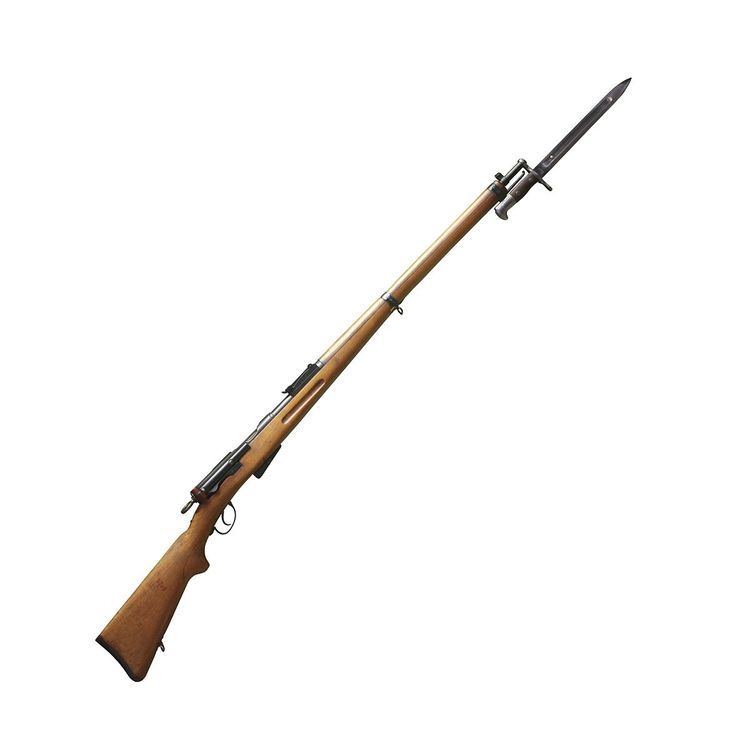Type Bolt action rifle In service 1889–ca. 1970 Manufacturer W+F Bern | Used by Swiss Army | |
 | ||
Designer Eduard Rubin and Rudolph Schmidt | ||
The Schmidt–Rubin rifles were a series of Swiss Army service rifles in use between 1889 and 1958. They are distinguished by the straight-pull bolt action invented by Rudolf Schmidt and use Eduard Rubin's 7.5×55mm Schmidt–Rubin rifle cartridge.
Contents
Schmidt–Rubin 1889
The Model 1889 was the first in the series of Schmidt–Rubin rifles which served Switzerland from 1889 to 1953. The rifle takes its name from the designer of its action, Colonel Rudolf Schmidt, and the designer of its ammunition, Colonel Eduard Rubin. Production of the rifle began in 1891. The straight-pull bolt action allows the user to pull the bolt straight back to unlock the action and eject the spent cartridge in one motion, and push the bolt forward to chamber a round, cock the striker, and lock the action. This is as opposed to a traditional bolt action, wherein the user must lift the bolt handle to unlock the action before pulling the bolt back. The rifle is roughly musket length with a free-floating barrel, 12-round magazine and wood stock that extends almost to the tip of the barrel. The Schmidt–Rubin 1889 was an advanced weapon for its time. The Schmidt–Rubin 1889 was one of the first rifles to use copper-jacketed ammunition as its standard ammunition. The GP90 7.5×53.5mm round designed by Col. Rubin in 1882 was revolutionary in that most of the bullets used in Europe at the time, except for the Mle 1886 Lebel rifle metal-jacketed 8mm bullet, were around .45 inches as opposed to the .308 inches of the Schmidt–Rubin ammunition. Strangely enough the round was "paper patched" meaning that the bullet was surrounded by a piece of paper, much like the cotton patches placed around a musket ball. Paper patching the round was supposed to aid in the lubrication of the bullet. In 1923, long after the discontinuation of the Model 1889, the GP90/23 7.5×53.5mm round was produced without the paper patching. The Model 1889 was eventually replaced by its successor models including the Model 1896, Model 96/11, Model 1911, Model 1911 carbine and the famous K-31.
Schmidt-Rubin Model 1896
The Schmidt-Rubin Model 1896 was the replacement for the 1889. Almost all the 1896 was converted to 96/11.
Schmidt-Rubin 1896/11 Rifle
The Schmidt-Rubin 1896/11 Rifle or the Model 96/11 was Switzerland's effort to upgrade the 1896 rifles it currently issued to use the more powerful cartridges of the Model 1911.
Model 1911 Rifle
An improvement over the original, 1889, version of the Schmidt–Rubin rifle, the Swiss M1911 placed the locking lugs in the middle of the bolt, rather than at the rear, strengthening the action and allowing a more powerful cartridge, the Gewehrpatrone 11 or GP 11 to be used. It is distinguished from the 96/11 rifle by a curved buttplate and by a stock with an integral semi-pistol grip. It uses a graduated tangent sight which begins at 300 meters. The 1911 and 96/11 rifles are characterized by exceptional accuracy and were made with excellent craftsmanship. The fact that Switzerland remained neutral through both world wars ensured that they are in far better condition, on average, than the rifles of other European nations from that vintage.
Model 1911 Carbine ("K11")
The Swiss at some point realized that its support troops, cavalry, and certain other units required a shorter rifle then what was currently available and so designed the Model 1911 Carbine. The Swiss 1911 Carbine being smaller, lighter and still lethally accurate, became a favorite of the Swiss Army and its popularity contributed to the design of its successor the K31.
